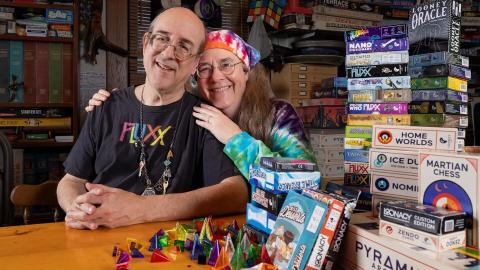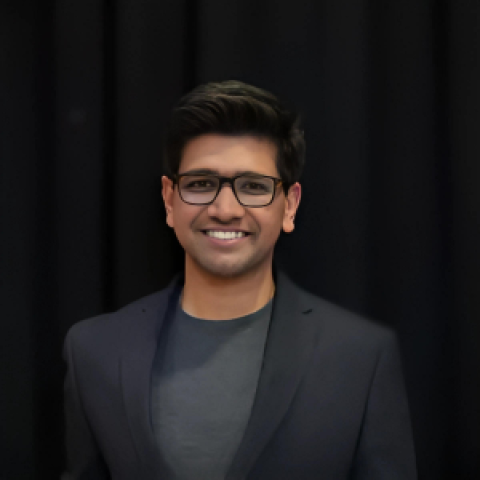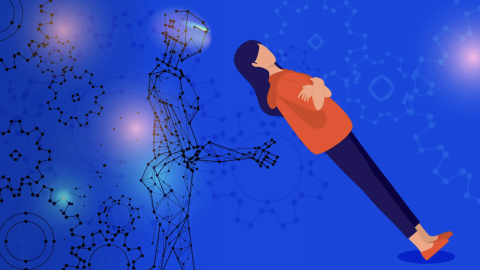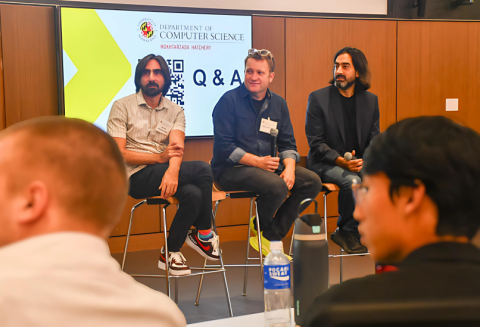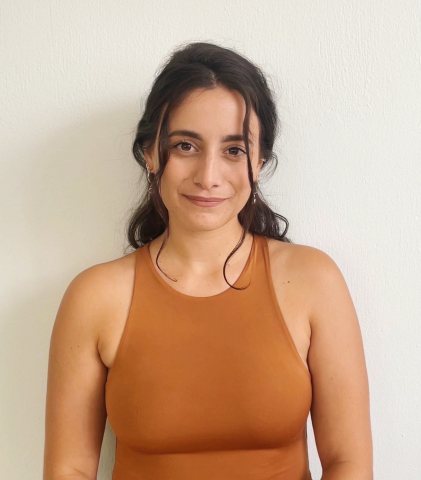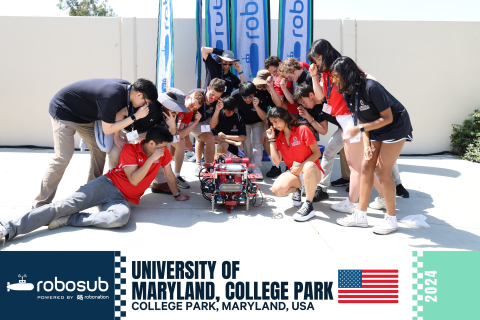Recent News & Accomplishments
2024
Alum couple takes a fluctuating, ever-changing, up-and-down journey to gaming success.
Andy Looney (B.S. ’86, computer science) sometimes wonders what his life would look like if he’d been born with a different last name. Would he have devoted his personal and professional ambitions to the wide world of whimsy as a Jones or a Smith? Which came first—the name, or the yearning for an off-kilter existence? Either way, Looney’s fate was sealed during the summer of 1986 when he met a “hippie chick who doesn’t wear shoes” named Kristin Wunderlich (B.S. ’88, computer science) working at NASA’s Goddard Space Flight Center. Her path was preordained as well: In German, “Wunderlich” means... read more
Nakul Garg is honored for his innovative contributions to low-power sensing and perception systems.
A University of Maryland doctoral student has been awarded a notable recognition for his research in sustainable computing and embedded intelligence. Nakul Garg , a sixth-year doctoral candidate in computer science, will receive the 2024 Paul Baran Young Scholar Award from the Marconi Society at a ceremony in Bologna, Italy, next month. The award is presented to promising young engineers who have demonstrated technical excellence and leadership in information and communications technology. This year, Garg was among four recipients selected from a competitive global pool to receive the award... read more
Akshaya Anand ’19 leads startup Korion Health to victory over 10,000 teams in an international social entrepreneurship competition.
A University of Maryland graduate seeking to transform the way patients gather critical heart and lung health data and her business partner have won $1 million to support their work. Korion Health co-founders Akshaya Anand (B.S. '19, computer science; B.S. '19, biological sciences; M.P.S. '23, machine learning) and Anna Li, a University of Pittsburgh and Carnegie Mellon University M.D./Ph.D. student, took first place at the annual Hult Prize challenge in London earlier this month, beating nearly 10,000 teams of young people from around the world with startups dedicated to solving social... read more
TRAILS announces $685,000 in seed funding to support interdisciplinary projects across its four partner institutions.
The Institute for Trustworthy AI in Law & Society (TRAILS) has announced its second round of seed funding, jumpstarting a series of interdisciplinary projects that align with the institute’s vision of advancing artificial intelligence (AI) systems that benefit all of society. The five grants announced today—totaling $685,000—will support efforts to improve AI-generated health information, enhance safety and trust in autonomous vehicles, address education disparities driven by race and location, examine AI-generated social media used during a pandemic or natural disaster, and build new... read more
The CyberCorps Scholarship for Service grant focuses on workforce development and expanding opportunities for students in cybersecurity.
The University of Maryland's Advanced Cybersecurity Experience for Students (ACES) program has renewed its CyberCorps Scholarship for Service (SFS) grant, securing nearly $5 million in funding from the National Science Foundation (NSF). The grant renewal, extending through April 2029, seeks to close gaps in the federal cybersecurity workforce by advancing education and workforce development initiatives. The CyberCorps SFS program funds cybersecurity education at universities across the U.S. Scholarship recipients commit to working for federal, state, local or government organizations after... read more
The Mokhtarzada Hatchery program offers students mentorship and connects them with entrepreneurs to refine their business ideas and gain practical experience.
The University of Maryland's Department of Computer Science organized its annual Fall Mokhtarzada Hatchery kick-off event on Thursday, September 12, 2024 , introducing students to the resources and opportunities available through the startup incubator. Held at the Brendan Iribe Center for Computer Science and Engineering , the event featured presentations about the program with Haroon (B.A. ’01, economics) and Zeki Mokhtarzada (B.S. ’01, computer science) and Arthur AI Founder and CEO Adam Wenchel (B.S. ’99, computer science), offering students a chance to learn how the Hatchery can support... read more
Philip Resnik analyzes the complex motivations that deter people from suicide in a Reddit study.
Concern about leaving devastated family members behind. The joy of raising a kitten. Thoughts of enemies who might gloat that they’d “won.” Those were some of the motivations that more than 16,000 Reddit users in September 2020 said had deterred them from taking their own lives. Other things that kept commenters from the edge included religion (both faith and fears), and profound wishes to understand their place in the universe. Still others expressed a desire to see how “Game of Thrones” would end or wrote about the power of a random hug from someone they barely knew—or even the lure of... read more
Briakou was recognized by the Association for Machine Translation in the Americas for her Ph.D. dissertation on improving translation understanding across languages.
Eleftheria Briakou (Ph.D. ’23, computer science) recently received the Best Thesis Award from the Association for Machine Translation in the Americas (AMTA). Now a research scientist at Google, Briakou was recognized for her dissertation, "Detecting Fine-Grained Semantic Divergences to Improve Translation Understanding Across Languages," which was commended for its innovative approach and significant contributions to machine translation. Briakou’s advisor, Associate Professor Marine Carpuat , guided her work, which addresses key challenges in translation by developing methods to automatically... read more
Holden, among eight honorees, was recognized for his leadership in labor rights and service to the university community.
Todd Holden , senior digital services developer at the University of Maryland’s Department of Computer Science, has been awarded the Governor’s Citation for Outstanding Service. The recognition, presented by Maryland Governor Wes Moore , acknowledges Holden’s work in both his professional capacity at the university and his leadership role within the state’s labor unions. The award was presented during a recent labor relations roundtable in Landover, Maryland. Holden has been a staff member of UMD since 2011, beginning his career as an IT web specialist. He transitioned into the role of... read more
Computer science undergraduates played key roles as UMD reached the semifinals.
Students from the University of Maryland's Department of Computer Science recently advanced to the semifinals of the 2024 RoboSub competition held in Irvine, California. The international competition, hosted annually, challenges student teams to design, build and program autonomous underwater vehicles (AUVs) capable of completing complex tasks that simulate real-world underwater scenarios. The UMD Robotics team , consisting of 16 members from various departments, included computer science majors Ishaan Ghosh (B.S. '26, computer science), Brant Jiang (B.S. '25, computer science) and Harshita... read more
